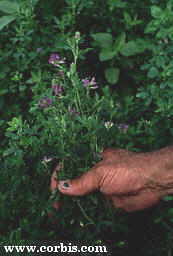
Melissa
Kaplan's
Herp Care Collection
Last updated
January 1, 2014
Use of sprouts vs. mature greens and whole beans
©1996 Melissa Kaplan
The Great Myth of the 60s and 70s is that sprouts are nutritious - they aren't! They are regarded as healthy for humans merely because they add some bulk and a bit a fiber to our generally fiber-deficient diets. For an herbivore, however, they may be worse than worthless nutritionally - they take up room in the gut that should be filled with more nutritious foods. Iguanas, under optimum conditions, can extract only 40% of the nutrients from the foods it ingests. When you let them fill up on nutritionally empty foods, like sprouts, radishes, cucumbers, zucchini, watermelon, grapes, mushrooms, green-and red-leaf lettuces, etc., you may actually depriving them of nutrients by using these foods instead of more nutritious alternatives.
From the University of California at Berkeley Wellness Letter (School of Public Health) V 12, N 1, 10/95:
"Bean sprouts are a good low-calorie way to liven up your salad or sandwich but they're no nutritional giants [emphasis mine], particularly since portions are typically small. Even if you eat half a cup of mung bean sprouts, you'll get only 7 mg of Vit C, about one-tenth the daily RDA, plus small amounts of iron and B vitamins. Alfalfa sprouts are the least nutritious."
As for feeding them to herbivores and omnivores, remember that all sprouts are extremely bulky so that the reptile is able to eat less of them than appropriately prepared leafy greens, vegetables, and mature alfalfa. As reptiles are able to extract out only part of the nutrients under the best of conditions (iguanas only 40%) it is extremely important to make sure that they are fed only nutrient dense foods and can fit as much of it into their gut as possible - so mince and finely shred hard veggies and fruits, and tear up most of the leafies into head-sized or smaller pieces...no slicing and dicing!
Mature alfalfa is at least 15% protein (~40 gm/cup), and has a 6:1 calcium ratio (protein content can range up to over 20%). By comparison:
| 1 cup of |
Protein
(gm) | Ca:P
Ratio |
| alfalfa sprouts | 1.32
| 1.2:3 |
| lentil sprouts |
6.9 |
1:7 |
| mung bean sprouts |
3.0 |
1:4 |
| mushrooms |
1.46 |
1:18 |
| navy beans |
14.8 |
1:8.5 |
| pinto beans |
43.5 |
1:3.4 |
| kidney beans |
14.4 |
1:3.7 |
| soy beans |
19.8 |
1:2.5 |
| tofu* |
7.8 |
1:1.8 |
| sweet (bell) peppers | 0.86
| 1:3.6 |
| romaine lettuce |
0.9 |
1:1 |
| iceberg lettuce |
0.7 |
1:1 |
*Note that 1/2 cup of soy tofu has over 200 mg of oxalate, making it comparable--and as undesireable, when it comes to healthy calcium metabolism--as spinach. (Source: OHF, Oxalate Content of Foods, May 2004 update).
Remember when feeding cooked, mashed beans as a protein source that beans, like all grains, are extremely low in calcium and high in phosphorous so you will need to add some additional calcium supplement to offset the imbalance. Beware too of feeding beans that are high in fat, such as soy beans and garbanzo beans (aka chickpeas): fat content in food can impede calcium metabolism, leading to metabolic bone disease if not properly supplemented.
Recent news indicates that sprouts can be contaminated with Salmonella...so be very careful if you decide to feed sprouts to your pets or yourself. More information can found at the Centers for Disease Control website.
Can't Tell The Difference Between Mature Alfalfa and Alfalfa Sprouts?
|
|
On the left is a mature alfalfa plant. Above is a clump of alfalfa sprouts.
|

